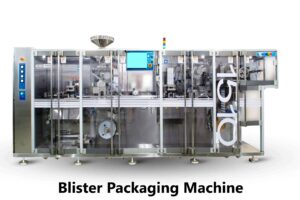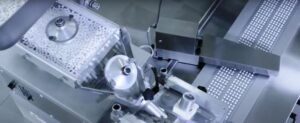The blister Packaging machine is used as a primary packing machine & used to pack the capsule, pill, tablet, and soft gel into aluminium-PVC/plastic blister packaging. The blister Packaging machine is widely used equipment in the pharma industries. An item of packing machinery called a blister packaging machine is used to create blister packs, which are little plastic pockets that contain tablets or capsules. Pharmaceuticals, food items, and small consumer goods are frequently packaged in blister packs. The blister packing machine creates the plastic pockets, places the goods inside, and then seals the pockets together. This kind of packaging shields the goods from outside contamination and aids in product preservation. Depending on the volume of production and the type of product being packaged, blister packaging machines can be fully automatic, semi-automatic, or manual.
Introduction & working principle:
The machines used for unit-dose packaging of tablets, capsules, soft gel, pills, etc. are called blister packing machines. A bubble pack component, which could be a cavity or pocket made of a formable film—typically thermoformed plastic or cold-formed aluminum film—is a part of this equipment. An electromechanical machine with both moving and stationary components is a blister packaging machine. Along with complete automation, this will also have a camera facility for quality control and quality check. Blister packing involves placing the products in pre-formed cavities created on the packaging material, filling them with the necessary components, and then sealing the cavities.

Types of packaging materials and principles of forming Blister Packs:
- Alum. and plastic (i.e. thermoforming) bubble pack for blister.
- Alum./Alum. (i.e. cold forming) bubble pack for blister.
- Alum./Plastic/Alum. bubble pack for the blister pack.

Process of Blister Packaging Machine:
The general process of the blister packaging is as per below:
Unwinding:
PVC plastic and aluminum foil are placed on the foil coiler and moved by a servo motor and rotating the forming station guided by rollers.

Film forming (drum type / flat type):
The plastic films can form in terms of thermoplasticity and form as per the shape required when transferred to the molding mold. The temperature will adjust as per the plastic film. Some hard plastic required 100- 140 ℃. The heat is transferred through the radiation heating method to heat the plastic film and the PVC films e molded into the required shape after being heated.

Different Blister packaging and forming methods:
Blister forming: Negative pressure forming is another name for the blistering process.
Positive pressure forming is often referred to as blow molding.
Punch-assisted blow molding: The softened PVC is squeezed with a punch before being blown into the mold.
Using two consecutive concave and convex molds for direct cold forming, cold stamping of convex and concave molds eliminates the need for heat.
Filling products:
The product is placed within the cavity as soon as it has formed and then quickly sealed. Using aluminum foil, the product is sealed.
Heat-sealing (drum type / flat type)
Then Immediately after filling the product in the cavity, the product needs to be sealed. Packaging Pill, Aluminium foil is generally used as per the material or product. So that there are two kinds of heat sealing:
Rolling type: The constantly simultaneous heat-sealing roller heat-seals the PVC tape and aluminum foil together. The speed of the rolls must be extremely slow and completely preheated in order to achieve a certified heat-sealing effect when the material passes through two rollers quickly.

Plate pressing type: In this the heated sealing plate and the lower template press the blister and the substrate for sealing.
Trimming, printing, and rejecting scrap:
Following the completion of the aforementioned stages, the pack will trim, print, and discard unnecessary work.
The essential details, including the date of manufacture and lot number, are then printed on the blister using the printer before the unqualified blister is ultimately removed. Additionally, certain devices can pack the blister directly. The blister packaging can be finished by following the aforementioned processes.
Critical Parameters of the Blister Packaging Machine
The blister packaging machine is a crucial piece of equipment in pharmaceutical tablet packaging, as it is responsible for creating blister packs that protect the tablets from moisture, air, and other contaminants while also providing convenient dosing and administration for patients. There are several critical parameters that need to be considered when operating a blister packaging machine in pharma tablet packaging. Some of these parameters include:
-
Temperature: The temperature settings of the blister packaging machine are critical in ensuring that the blister packs are properly sealed. The sealing temperature should be set accurately to ensure that the plastic film used to create the blister packs is heated to the appropriate temperature to form a strong and secure seal. Too low or too high-temperature settings can result in inadequate seals, leading to compromised product integrity.
-
Pressure: The pressure applied during the sealing process is also important. Sufficient pressure needs to be applied to ensure that the plastic film is pressed firmly against the tablet-containing cavities, creating a tight seal. Too little pressure may result in incomplete sealing, while excessive pressure may damage the tablets or the packaging materials.
-
Dwell time: Dwell time refers to the duration for which the sealing temperature and pressure are applied to the blister packs. It is essential to determine the optimal dwell time for the specific type of tablets being packaged, as it can impact the quality of the seal. Too short a dwell time may result in inadequate sealing, while too long a dwell time may cause overheating or melting of the plastic film.
-
Film tension: The tension of the plastic film used in blister packaging is crucial in ensuring that the film is properly stretched over the tablet-containing cavities. The appropriate film tension helps in achieving uniformity in the blister pack formation and ensures that the tablets are securely held in place. Too high or too low film tension can result in issues such as film wrinkles, misalignment of tablets, or incomplete sealing.
-
Forming depth: The forming depth of the blister packs, which refers to the depth of the cavities that hold the tablets, needs to be accurately set to ensure that the tablets fit snugly in the cavities without any movement. The forming depth should be appropriate for the size and shape of the tablets being packaged, and it needs to be consistent across all the blister packs to maintain uniformity.
-
Speed: The speed of the blister packaging machine, which refers to the rate at which the blister packs are formed, filled, and sealed, is another critical parameter. The speed should be set at an optimal level that allows for efficient and consistent production without compromising the quality of the blister packs.
-
Material specifications: The specifications of the packaging materials, including the type and thickness of the plastic film used for blister packs, must be carefully considered. The material specifications should be suitable for the type of tablets being packaged and should comply with regulatory requirements for pharmaceutical packaging, including barrier properties, stability, and compatibility with the tablets.
-
Environmental conditions: The environmental conditions in which the blister packaging machine operates, such as temperature and humidity, can also impact the quality of the blister packs. The machine should be operated within the recommended environmental conditions specified by the manufacturer to ensure consistent performance and reliable sealing.
It is important to note that the critical parameters of a blister packaging machine may vary depending on the specific type of tablets being packaged, the type of packaging materials used, and the design and specifications of the blister packaging machine. Therefore, it is crucial to consult the manufacturer’s guidelines and conduct appropriate validation and testing to determine the optimal settings for the specific packaging process. Regular monitoring and adjustment of these critical parameters during operation are also essential to maintain the quality and integrity of the pharmaceutical tablets in blister packs.
Types of Blister Machines available in markets:
- Blister packing device with rollers.
- Blister packing machine with roller plates.
- Machine for flat plate blister packaging.

Major Components of Blister packaging machine:
- Forming Station: Intermittent compressed air forming
- Sealing Station: Continuous rotary
- Full Function with PLC & Industrial PC.
- Edge To Edge pack cutting
- Feeding Arrangements: Brush feeder/ dedicated feeder/ multi-feeder
The features are taken into account for URS:
- Automation
- Quality control system
- Minimum tool changeover.
- Compact and simple to operate the unit.
- A closed system that produces little dust.
- Simplicity of upkeep
- Little to no nooks and recesses make it simple to clean.
- All welded joints are to be grinded where the product may be in contact to smooth finish and lead-free.
- All gaskets that are provided to prevent leaks should be simple to remove and reinstall, and all electrical and pneumatic components should be pre-wired.
- It is recommended for all bolts and nuts on the equipment’s exterior to have a cap head or cap nut.
- Those components that need to be cleaned should have quick-fixing provisions.
- Parts which are required for cleaning should be provided with quick fixing arrangement
- All the contact parts should be SS 316L non-contact parts preferably of SS 304. The electrical panel and the complete base structure of the device are lined with non-flameproof SS 304.
Certification & Documentations of Blister Packaging Machine:
- GA Drawing & P&ID, Complete set of Top, Side & Elevation view.
- MOC certificates of all contact & major non-contact parts.
- The complete set of DQ, IQ and all documents are as per URS.
FAQ:
What is blister packaging machine?
Answer: Blister packing machines are specialized equipment used to package tablets, capsules, and other unit-dose medications. A bubble pack component, which could be a cavity or pocket made of a formable film—typically thermoformed plastic or cold-formed aluminum film—is a part of the device. This often has an aluminum foil lidding closure. In another way, this is an electromechanical device that helps package and seal goods in pre-formed cavities by having both stationary and moving elements.
How much is a blistering machine?
Answer: The price of the blister machine varies from 2 lacs to 1.5 cr depending of the capacity and automation requirements.
What is the use of blister machine?
Answer: Blister machine used to package tablets, capsules, and other unit-dose drugs or medicines.
Blister Packaging Machine Manufacturers
There are lots of manufacturers worldwide for the blister machine, but some of the best manufacturers are:
- Accupack Engineering.
- IWK
- Jicon
- Elmech
- Helios Concrew
- ACG
- Lodha
- Parle Global
For more technical details, best equipment vendor comparison of Blister Packaging Machine, or any type of documentation. (SOP,DQ,IQ,OQ,PQ etc.) Please contact: admin@flairpharma.com
